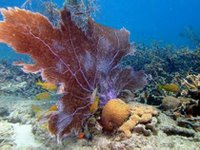 DRY TORTUGAS NATIONAL PARK, Florida (Reuters) - In the azure waters of Florida's remote Dry Tortugas National Park, corals have been toppled by hurricanes and blighted by disease and a phenomenon known as bleaching.
DRY TORTUGAS NATIONAL PARK, Florida (Reuters) - In the azure waters of Florida's remote Dry Tortugas National Park, corals have been toppled by hurricanes and blighted by disease and a phenomenon known as bleaching. Eight hurricanes in two years and a plague of disease that swept the Caribbean recently have damaged the colorful, thick carpets of open-water coral reefs in the 100-square-mile (260-sq-km) park off Florida's southwest coast.
With another hurricane season under way and diseases such as white plague getting an early start this year, scientists surveying the reef expressed heightened concern for the fragile corals, which are important nurseries and habitats for marine life and harbingers of the health of the seas.
"There are some areas out here that are like a parking lot, absolutely denuded," said Dr. Jerry Ault, associate professor of marine biology and fisheries at the University of Miami's Rosenstiel School of Marine & Atmospheric Science.
Ault supervised a team of nearly 40 divers aboard the 100-foot (30-meter) research vessel Spree recently as they conducted a three-week, $300,000 biennial census, surveying coral, fish and lobster.
The Dry Tortugas are a cluster of seven tiny islands and acres (hectares) of coral seabed located 70 miles southwest of Key West, a popular tourist island at the southern tip of the Florida peninsula.
"Since 2004, we have had eight storms that have tracked within 100 miles of the Tortugas," said Ault. "In 2005, this was ground zero for major storms.
"Are we afraid of another hurricane season? Three (bad) hurricane seasons can't be a good thing."
"Coral reefs are in a state of decline around the world," said Billy Causey, acting regional manager for national marine sanctuaries in the southeast United States. "At least we have protections in place. There's probably not a piece of coral reef real estate that is any more protected."
